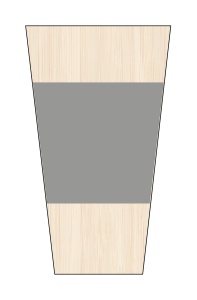Goal: flatter, easier to play, more free blowing
Plan: Remove cane for flatter intonation and ease, working closer to the spine for a more free-blowing quality. Begin working in the front and middle thirds, leaving the back as strong as possible, and work according to the quality of your cane and the reed’s natural break-in period. These issues are a common symptom of cane not holding the trim. They can also mean that the entire reed is too heavy.
Suggestions for Finer Work
- Is the critical point the correct thickness? (60-61 hundredths of a millimeter OR 24-25 thousandths of an inch)
- Is the reed the correct length? (29 mm from the top of the first wire to the tip)
- How is the tip opening? Can you flatten the first wire?
- Is too much lip pressure required? If so, lightly brush with the file as shown in Image 1.
- Return to the DBL model to see more tests that can be performed.

Image 1